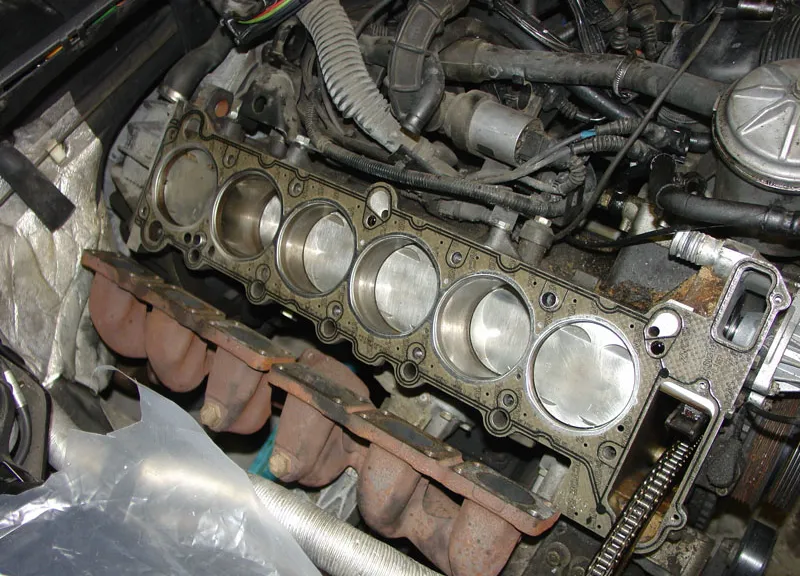If you’re driving a BMW E39 and have started noticing strange engine behavior, it could be a sign of a serious problem—a blown head gasket. The head gasket plays a critical role in your engine, ensuring that coolant and oil remain separate while maintaining engine compression. When it fails, it can cause a variety of engine problems. Early detection of a blown head gasket can save you from costly repairs and engine damage. In this article, we’ll explore BMW E39 blown head gasket symptoms, how to diagnose it, and what steps to take if you suspect you have one.
What is a Head Gasket and Why is It Important in Your BMW E39?
The Function of the Head Gasket
The head gasket is a vital engine component that sits between the engine block and cylinder head. It’s responsible for creating a tight seal to prevent coolant and oil from mixing. The gasket also ensures that the combustion gases remain contained within the cylinders, maintaining proper engine compression. Without a properly functioning head gasket, these critical functions are compromised, leading to overheating, poor engine performance, and potentially catastrophic engine damage.
What Happens When the Head Gasket Fails?
When the head gasket fails, coolant can leak into the combustion chamber or mix with the engine oil. This can result in a variety of issues, including overheating, poor engine performance, and even severe engine damage. If left untreated, a blown head gasket can cause significant damage to other engine components, including the cylinder head and pistons, which could lead to an expensive repair or replacement.
Common BMW E39 blown head gasket symptoms
Overheating Engine
One of the most common symptoms of a blown head gasket in the BMW E39 is engine overheating. A compromised head gasket can disrupt the flow of coolant, either allowing coolant to leak out or to enter the combustion chamber. This leads to a significant rise in engine temperature. If you notice that your engine is running hot, even after topping off the coolant, it could be a sign of a blown head gasket. Overheating can cause further damage to the engine, so it’s essential to address this symptom as soon as possible.
White Smoke from the Exhaust
Another obvious sign of a blown head gasket is white smoke coming from the exhaust. When coolant leaks into the combustion chamber, it gets burned off along with the air-fuel mixture, producing white smoke. If you see persistent white smoke billowing from your exhaust, it’s a strong indicator that coolant is entering the engine. This is a clear sign of a head gasket failure, and you should have it inspected immediately to prevent further damage.
Coolant and Oil Mixing
If coolant and oil are mixing, you will often notice a milky, frothy substance on the oil dipstick or under the oil filler cap. This happens when coolant leaks into the oil passages due to a blown head gasket. If you notice this milky substance, it’s a sign that coolant and oil are contaminating each other. This is a critical issue, as it can affect the oil’s ability to lubricate the engine properly, leading to severe engine damage if not addressed immediately.
Unexplained Coolant Loss
A blown head gasket can also cause coolant loss without visible external leaks. If you’re frequently topping off your coolant reservoir and can’t find any visible leaks, it’s likely that coolant is leaking into the engine through the head gasket. This internal leak can lead to low coolant levels, which can cause overheating and further engine damage. If you notice this symptom, it’s important to check for other signs, such as white smoke or overheating.
Bubbling Coolant
Bubbling coolant in the reservoir is another symptom of a blown head gasket. If you see bubbles in the coolant reservoir or overflow tank, it’s likely that exhaust gases are entering the cooling system through the damaged head gasket. This disrupts the normal coolant circulation and can lead to overheating. Bubbling coolant is a clear sign of a head gasket problem and should be addressed immediately.
Engine Misfires
A blown head gasket can disrupt the combustion process, leading to engine misfires. Misfires occur when the engine’s cylinders fail to fire properly, which can cause rough idling, reduced engine power, and even stalling. If you notice rough idling or engine misfires, it could be a result of a blown head gasket affecting the combustion process.
Loss of Power
Another sign of a blown head gasket is a noticeable loss of power, especially when accelerating or under load. A compromised head gasket can cause a loss of compression in the engine’s cylinders, leading to reduced engine performance. If your BMW E39 feels sluggish, struggles to accelerate, or lacks power when driving uphill, it could be due to a blown head gasket.
Diagnosing a Blown Head Gasket in Your BMW E39
Visual Inspection of the Coolant Reservoir
Start by visually inspecting the coolant reservoir for signs of bubbling or frothy coolant. Bubbles in the coolant are a strong indication of exhaust gases entering the cooling system, a key sign of a blown head gasket. Perform this inspection when the engine is running, as it’s more likely to show the symptoms.
Checking the Oil Dipstick for Milky Residue
Next, check the oil dipstick for a milky or frothy substance. This is a clear indication that coolant has mixed with the oil, which is a sign of a blown head gasket. If you notice this symptom, it’s crucial to stop driving the car immediately and have it inspected by a mechanic.
Performing a Compression Test
A compression test is an essential diagnostic tool when dealing with a suspected blown head gasket. This test measures the pressure in each cylinder. If one or more cylinders show low compression, it’s a sign that the head gasket is compromised, leading to loss of compression. This test can help confirm if the head gasket is the problem.
Using a Hydrocarbon Sniffer to Detect Combustion Gases
A hydrocarbon sniffer is a tool used to detect exhaust gases in the coolant system. This diagnostic tool can help confirm the presence of combustion gases leaking into the cooling system, which is a key indicator of a blown head gasket. If you suspect a blown gasket, using a hydrocarbon sniffer will provide a definitive answer.
 source:https://www.bimmerforums.com/
source:https://www.bimmerforums.com/
Preventing a Blown Head Gasket in Your BMW E39
Regular Maintenance and Coolant Inspections
Preventing a blown head gasket starts with regular maintenance. Make sure to inspect your coolant system regularly, check for leaks, and replace the coolant at recommended intervals. Proper maintenance of the cooling system ensures that your BMW E39’s engine stays at the right temperature and prevents overheating.
Monitoring Engine Temperature and Oil Condition
Keep an eye on your engine’s temperature gauge to ensure that it’s running at a proper temperature. If the engine begins to overheat, address the issue immediately to prevent damage to the head gasket. Additionally, changing the engine oil regularly and checking for oil contamination can help maintain optimal performance and prevent head gasket issues.
What to Do if You Suspect a Blown Head Gasket in Your BMW E39
Immediate Actions to Take
If you notice any of the symptoms of a blown head gasket, it’s important to stop driving your BMW E39 immediately. Continuing to drive with a blown head gasket can cause severe damage to the engine, leading to costly repairs. Contact a mechanic or tow the car to a repair shop for a proper diagnosis.
Repair vs. Replacement: Which is the Best Option?
If your BMW E39 has a blown head gasket, you’ll need to decide between repair or replacement. Repairing a head gasket is usually less expensive, but it may only be a temporary fix if the engine has suffered significant damage. If the engine has suffered extensive damage, replacing the head gasket or even the entire engine may be necessary.
FAQS on BMW E39 blown head gasket symptoms
How Long Can I Drive My BMW E39 with a Blown Head Gasket?
It’s highly advised to avoid driving your BMW E39 with a blown head gasket. Driving with a compromised gasket can lead to further engine damage, including warped cylinder heads or damaged pistons. If you suspect a blown head gasket, have it inspected immediately.
How Much Does It Cost to Replace a BMW E39 Head Gasket?
Replacing a head gasket in a BMW E39 can be costly, typically ranging from $1,500 to $2,500, depending on labor and parts costs. If the engine has suffered further damage, the cost could be even higher.
Can I Prevent a Blown Head Gasket in My BMW E39?
Regular maintenance, including coolant system inspections, monitoring engine temperature, and changing oil regularly, can help prevent a blown head gasket. Ensuring that your BMW E39 stays within optimal operating conditions is key to preventing this issue.
What Happens if a Blown Head Gasket Goes Untreated?
If left untreated, a blown head gasket can cause significant damage to the engine, including warped cylinder heads, damaged pistons, and even complete engine failure. It’s crucial to address the issue as soon as you notice the symptoms to avoid costly repairs.
Final thoughts: BMW E39 blown head gasket symptoms
A blown head gasket in your BMW E39 is a serious issue that can lead to significant engine damage if not addressed promptly. Watch for common symptoms like overheating, white smoke, coolant loss, and oil mixing with coolant. If you notice any of these symptoms, it’s essential to stop driving the car and have it inspected immediately. Regular maintenance and early detection are key to preventing expensive repairs and keeping your BMW E39 running smoothly for years to come.

